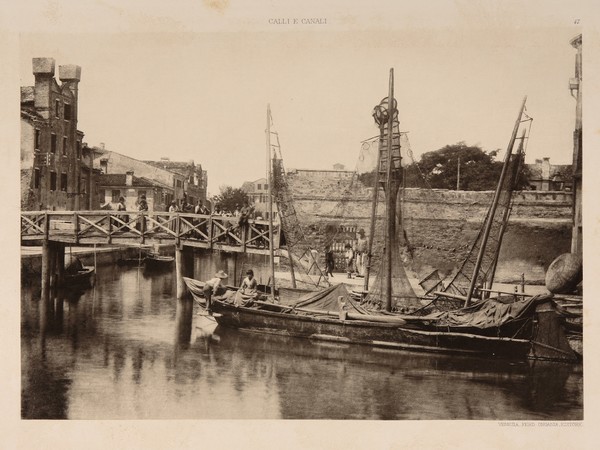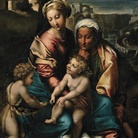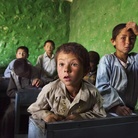Ferdinando Ongania. Light on Venice. Travel in the photography of nineteenth century

Ferdinando Ongania, Isola della Giudecca, rio interno
From 12 Aprile 2014 to 02 Novembre 2014
Stra | Venice
Place: National Museum of Villa Pisani
Address: via Doge Pisani 7
Times: 9am-8pm. From 1st October 9am-5pm; closed on Monday
Responsibles: Myriam Zerbi, Sabina Vianello
Organizers:
- Soprintendenza per i Beni Architettonici e Paesaggistici per le Province di Venezia Belluno Padova e Treviso
Ticket price: full € 10, reduced € 7.50, free for citizens UE till 18 and over 65
Telefono per informazioni: +39 049 502074
E-Mail info: sbap-vebpt.villapisani@beniculturali.it
Official site: http://www.villapisani.beniculturali.it
The National Museum of Villa Pisani hosts from April 12 to November 2, 2014, the exhibition Light on Venice. Travel in the photography of nineteenth century, promoted by the Superintendence for Architectural Heritage and Landscape for the Province of Venice , Belluno, Padova and Treviso and organized by Munus, which has the dual photographic masterpiece of Ferdinand Ongania (Venice 1842 - St. Moritz 1911) Streets and Canals and Streets, canals and islands of the lagoon, for the first time fully exposed .
Ferdinand Ongania was undoubtedly the largest publisher in the Venetian turn of the century, ingenious and brilliant heir to the tradition of the famous Aldus typographical he had done in Venice, "a place more akin to a world that in a city," the major center European publishing between the fifteenth and sixteenth centuries. By documenting the evolution of the modes and forms of landscape photography Venetian between the second half of the nineteenth century and the first decades of the twentieth century , as a publisher , Ongania marks a milestone in consolidating and validate the path of ' writing with light ' ( photo -graphy ) as urban portrait , creating , with Calli and channels , an extraordinary ' landmark paper ' the Venice of the late nineteenth century and its social reality.
There are two hundred precious original nineteenth-century , photo- engravings that record faithfully the image of the city, the places with the fields, the streets , the islands , bringing back a detailed figurative and the majesty of the buildings reflected in the water and monumental areas made famous by that landscape painting by Canaletto on, makes icons towns . Next to Saint Mark's Square , the Bridge of Sighs , the Grand Canal and the Rialto Bridge , appear less known corners of a " Minor Venice " Santa Marta as San Pietro di Castello , the places that painters and photographers were discovering and attending on wake of the poetic truth that developed in the second half of the nineteenth century . The glorious history of the Serenissima binds in the shots chosen by Ongania to tell his Venice, the everyday reality of contemporary life with sailing ships that ply the waters of the basin of San Marco, the characters moving gondola protected by felze , fishermen Channel Giudecca , ladies walking in the Piazzetta with sun umbrellas. The "new vision " should be photographic staring in those years, new ways of looking at the Venetian landscape , far from the stereotypes known , in the silence of the lagoon, the boats of fishermen between the sandbanks and islands of Murano, Burano and Torcello as of Vignole, Mazzorbo or of St. Francis of the desert.
In the shop that had the windows in sottoportego Square , the numbers 72, 73 and 74 of the Napoleonic Wing , opened in the late forties by the German Friedrich Hermann Munster, Ongania began working as a boy, becoming , by salesperson, director of the firm , and finally detecting the activity in 1871. atelierOngania in his sells antique books , antique prints , paintings and photographs by contemporary artists of the time, as well as objects of art and works of various kinds of antiques, relying on a network direct relationships with many collectors . With the proceeds of this activity is dedicated to publishing illustrated books on art , achieving amazing results in the field .
The forge of Ongania , where there is even a room for making music , recorded by John Ruskin in The Stones of Venice , became a popular meeting place for artists, writers, bibliophiles and Italian and foreign scholars , the place chosen by the likes of John Ruskin , Pompey Molmenti , Peter Wild , Alvise Zorzi and Camillo Boito , who come together turning the debate on the emergence of conservation and restoration of Venice and its monuments and the need for the protection of artistic and architectural heritage that the city has to start from ' careful study and documentation of the goods must be as accurate and objective as possible .
Highlighted in the cultural debate of the time the role of photography , then lived as a science as well as art, and the value of the new medium in the representation of the urban landscape , with its potential to be a living witness and realistic, Ferdinand Ongania conceives and initiates the project to photograph the places of the city with its inhabitants and produced the first major photographic collections of the period who join unquestionable documentary value the aesthetic taste of cuts and scholars studied the play of light and shadows that give a flavor of the shots striking beauty.
An exhibition of photo - 200 original etchings that make up the dual collection Ongania Corns and Calluses and channels , canals and islands of the lagoon , a gallery of original nineteenth century that precious document for the entire enterprise Ongania , reviving the story of Venice in the late nineteenth century in an evocative portrait of the city and the social reality of the time.
The National Museum of Villa Pisani has for years been engaged in the development and dissemination of the artistic heritage of nineteenth- and acquired in this vein with a known specificity exhibition exhibitions Emma Ciardi 1879-1933 . Impressionism Veneziano (2009) ; Nineteenth century Venetian (2010) ; Water landscapes . Lights and Reflections in Venetian painting 800 ( 2011); Nobility of work . Arts and Crafts in Venetian painting between 800 and 900 (2012) ; Venice of the century in photographs of Tomaso Filippi (2013) .
The exhibition is promoted by the Superintendence for Architectural and Landscape Heritage for the provinces of Venice , Belluno, Padova and Treviso , directed by Antonella Rinaldi , is headquartered at the National Museum of Villa Pisani in Stra ( Venice) , directed by Joseph Rallo , is organized by Munus , concessionaire of additional services to the Villa Pisani and is curated by Myriam Zerbi and Sabina Vianello. The exhibition is organized in collaboration with the Archives Carlo Montanaro and the University IUAV of Venice.
Ferdinand Ongania was undoubtedly the largest publisher in the Venetian turn of the century, ingenious and brilliant heir to the tradition of the famous Aldus typographical he had done in Venice, "a place more akin to a world that in a city," the major center European publishing between the fifteenth and sixteenth centuries. By documenting the evolution of the modes and forms of landscape photography Venetian between the second half of the nineteenth century and the first decades of the twentieth century , as a publisher , Ongania marks a milestone in consolidating and validate the path of ' writing with light ' ( photo -graphy ) as urban portrait , creating , with Calli and channels , an extraordinary ' landmark paper ' the Venice of the late nineteenth century and its social reality.
There are two hundred precious original nineteenth-century , photo- engravings that record faithfully the image of the city, the places with the fields, the streets , the islands , bringing back a detailed figurative and the majesty of the buildings reflected in the water and monumental areas made famous by that landscape painting by Canaletto on, makes icons towns . Next to Saint Mark's Square , the Bridge of Sighs , the Grand Canal and the Rialto Bridge , appear less known corners of a " Minor Venice " Santa Marta as San Pietro di Castello , the places that painters and photographers were discovering and attending on wake of the poetic truth that developed in the second half of the nineteenth century . The glorious history of the Serenissima binds in the shots chosen by Ongania to tell his Venice, the everyday reality of contemporary life with sailing ships that ply the waters of the basin of San Marco, the characters moving gondola protected by felze , fishermen Channel Giudecca , ladies walking in the Piazzetta with sun umbrellas. The "new vision " should be photographic staring in those years, new ways of looking at the Venetian landscape , far from the stereotypes known , in the silence of the lagoon, the boats of fishermen between the sandbanks and islands of Murano, Burano and Torcello as of Vignole, Mazzorbo or of St. Francis of the desert.
In the shop that had the windows in sottoportego Square , the numbers 72, 73 and 74 of the Napoleonic Wing , opened in the late forties by the German Friedrich Hermann Munster, Ongania began working as a boy, becoming , by salesperson, director of the firm , and finally detecting the activity in 1871. atelierOngania in his sells antique books , antique prints , paintings and photographs by contemporary artists of the time, as well as objects of art and works of various kinds of antiques, relying on a network direct relationships with many collectors . With the proceeds of this activity is dedicated to publishing illustrated books on art , achieving amazing results in the field .
The forge of Ongania , where there is even a room for making music , recorded by John Ruskin in The Stones of Venice , became a popular meeting place for artists, writers, bibliophiles and Italian and foreign scholars , the place chosen by the likes of John Ruskin , Pompey Molmenti , Peter Wild , Alvise Zorzi and Camillo Boito , who come together turning the debate on the emergence of conservation and restoration of Venice and its monuments and the need for the protection of artistic and architectural heritage that the city has to start from ' careful study and documentation of the goods must be as accurate and objective as possible .
Highlighted in the cultural debate of the time the role of photography , then lived as a science as well as art, and the value of the new medium in the representation of the urban landscape , with its potential to be a living witness and realistic, Ferdinand Ongania conceives and initiates the project to photograph the places of the city with its inhabitants and produced the first major photographic collections of the period who join unquestionable documentary value the aesthetic taste of cuts and scholars studied the play of light and shadows that give a flavor of the shots striking beauty.
An exhibition of photo - 200 original etchings that make up the dual collection Ongania Corns and Calluses and channels , canals and islands of the lagoon , a gallery of original nineteenth century that precious document for the entire enterprise Ongania , reviving the story of Venice in the late nineteenth century in an evocative portrait of the city and the social reality of the time.
The National Museum of Villa Pisani has for years been engaged in the development and dissemination of the artistic heritage of nineteenth- and acquired in this vein with a known specificity exhibition exhibitions Emma Ciardi 1879-1933 . Impressionism Veneziano (2009) ; Nineteenth century Venetian (2010) ; Water landscapes . Lights and Reflections in Venetian painting 800 ( 2011); Nobility of work . Arts and Crafts in Venetian painting between 800 and 900 (2012) ; Venice of the century in photographs of Tomaso Filippi (2013) .
The exhibition is promoted by the Superintendence for Architectural and Landscape Heritage for the provinces of Venice , Belluno, Padova and Treviso , directed by Antonella Rinaldi , is headquartered at the National Museum of Villa Pisani in Stra ( Venice) , directed by Joseph Rallo , is organized by Munus , concessionaire of additional services to the Villa Pisani and is curated by Myriam Zerbi and Sabina Vianello. The exhibition is organized in collaboration with the Archives Carlo Montanaro and the University IUAV of Venice.
SCARICA IL COMUNICATO IN PDF
COMMENTI

-
 Dal 31 gennaio 2024 al 04 maggio 2025
Fermo | Palazzo dei Priori
Dal 31 gennaio 2024 al 04 maggio 2025
Fermo | Palazzo dei Priori
-
 Dal 20 dicembre 2024 al 04 maggio 2025
Fermo | Palazzo dei Priori
Dal 20 dicembre 2024 al 04 maggio 2025
Fermo | Palazzo dei Priori
-
 Dal 20 dicembre 2024 al 04 maggio 2024
Gorizia | Palazzo Attems Petzenstein
Dal 20 dicembre 2024 al 04 maggio 2024
Gorizia | Palazzo Attems Petzenstein
-
 Dal 18 dicembre 2024 al 18 dicembre 2024
Venezia | Museo Correr
Dal 18 dicembre 2024 al 18 dicembre 2024
Venezia | Museo Correr
-
 Dal 14 dicembre 2024 al 02 marzo 2025
Palermo | Palazzo Abatellis
Dal 14 dicembre 2024 al 02 marzo 2025
Palermo | Palazzo Abatellis
-
 Dal 12 dicembre 2024 al 23 febbraio 2025
Roma | Palazzo Altemps
Dal 12 dicembre 2024 al 23 febbraio 2025
Roma | Palazzo Altemps


